The Lowcountry means something different to everyone. Whether it’s live oaks draped in Spanish moss, big sandy beaches, winding salt marsh mazes, or fine art—everyone from the southeastern United States knows something about the Lowcountry. To us, it’s a place to throw flies to five-star gamefish 12 months a year.
In the springtime, when we’ve had about enough of fishing the marshes for juvenile redfish, we’re excited for new targets to migrate our way. The first species I usually come across is bluefish. Bluefish are fun on fly rods because they’re aggressive and mean. If the redfish you were fishing for last winter were like Kenny G, then these bluefish are more like Ozzy Osbourne. They don’t care what you feed them as long as they have a chance to bite the head off of your fly and spit it onto the deck. Bluefish are fun to chase around nearshore reefs, but they can also be found in tidal rips. White birds are a sure sign that there are bluefish in the area. Some of the most entertaining fly fishing in springtime is running and gunning around the beaches, following the terns and gulls with hungry fish just below the surface. The bluefish in this area typically range between 1 and 5 pounds and can be taken on lighter tackle. My go-to is a 6- or 7-weight rod with a floating or intermediate line. Long-shank hooks are great in sizes 2 to 3/0. I tie my flies just above the bend and use the long exposed shank as a bite guard. I try to avoid hair and feathers because they only last a fish or two. Instead, I have better luck with white, red, and pink craft fur and EP, or SF fiber. When fishing for bluefish, flash and epoxy are your friends. Don’t forget to pack some poppers when the bite is hot!
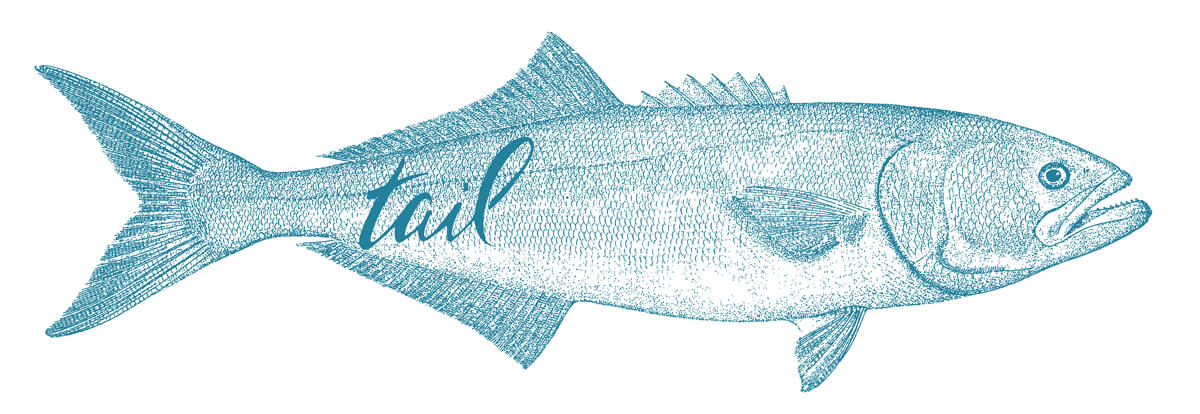 Another high-intensity spring target is the Spanish mackerel. They, too, are vicious, blood-splattering, toothy critters that will readily take a fly. Spanish mackerel are a lot like bluefish and can often be found around the same rips, reefs, and beaches. Running and gunning the beaches for Spanish mackerel is a blast on 7- and 8-weight rods. The larger spawning mackerel weigh almost into the double digits and can easily get you into your backing. The bigger fish are not quite as reckless as the schoolies, so more realistic baitfish patterns are the norm. Chum will greatly increase your odds of hooking large mackerel on the fly. Targeting big Spanish mackerel without fresh chum is like a throwing a college party without beer. Your party will last only a few minutes before all the hot girls leave. Floating and intermediate lines do the trick in most cases. I also pack a reel with a 250- to 300-grain sinking line for when I am marking the fish on sonar but can’t seem to raise them. Baitfish patterns tied in green, white, pink, red, and most combinations thereof, will do the trick on 1/0 to 4/0 hooks. I like the more durable synthetic flies over hair for them as well. Since Spanish mackerel attack from all angles, I use a 6-inch section of stranded 30-pound wire as a bite guard. Avoid using small swivels or larger profile knots to attach the bite guard because mackerel like to eat knots when small baits are around. If the Spanish mackerel’s big brother, the king mackerel, shows up in the process, a reel with 200 yards of backing should buy you some time while your guide or buddy initiates the chase!
Another high-intensity spring target is the Spanish mackerel. They, too, are vicious, blood-splattering, toothy critters that will readily take a fly. Spanish mackerel are a lot like bluefish and can often be found around the same rips, reefs, and beaches. Running and gunning the beaches for Spanish mackerel is a blast on 7- and 8-weight rods. The larger spawning mackerel weigh almost into the double digits and can easily get you into your backing. The bigger fish are not quite as reckless as the schoolies, so more realistic baitfish patterns are the norm. Chum will greatly increase your odds of hooking large mackerel on the fly. Targeting big Spanish mackerel without fresh chum is like a throwing a college party without beer. Your party will last only a few minutes before all the hot girls leave. Floating and intermediate lines do the trick in most cases. I also pack a reel with a 250- to 300-grain sinking line for when I am marking the fish on sonar but can’t seem to raise them. Baitfish patterns tied in green, white, pink, red, and most combinations thereof, will do the trick on 1/0 to 4/0 hooks. I like the more durable synthetic flies over hair for them as well. Since Spanish mackerel attack from all angles, I use a 6-inch section of stranded 30-pound wire as a bite guard. Avoid using small swivels or larger profile knots to attach the bite guard because mackerel like to eat knots when small baits are around. If the Spanish mackerel’s big brother, the king mackerel, shows up in the process, a reel with 200 yards of backing should buy you some time while your guide or buddy initiates the chase!
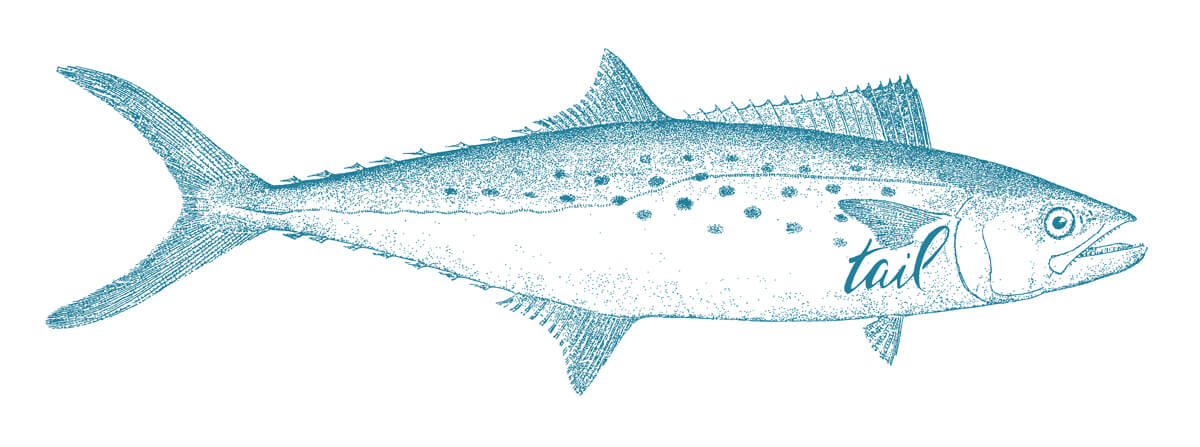
One of my favorite migratory fish, which shows up shortly after the bluefish and Spanish mackerel, is the cobia. Cobia look like a shark mixed with a catfish, and they’re known for being curious to a fault. These fish literally swim straight to the boat like kamikaze pilots. Inshore cobia have taken quite a hit from meat fishermen in the last decade, but we’re still seeing fish in the 10- to 40-pound-plus range daily during the spawn. Slick calm, slack tide, and sunshine are ideal for fly fishing for cobia. I typically ride in the tower of my Jones Brothers with my angler on the bow, fly rod in hand, in search of wakes and Vs on the surface. Once I find one, I’ll parallel the fish about 50 feet away and intercept the fish from a 90-degree angle with the fly. So long as you can drop the fly where it needs to be, a bite typically follows. Baitfish patterns like the EP Peanut Butter Baitfish, Whistlers, and zonker-strip flies make for good cobia food. Cobia have strange bottom lips that require sharp, wide-gap hooks. Hooks 5/0 and larger dressed with orange, white, red, green, or pink patterns will please old brownie. With such a wide size range of cobia, I stick with a 10-weight rod with weight-forward floating line. A 10-weight is not too heavy for the little guys and not too light for the big ones.
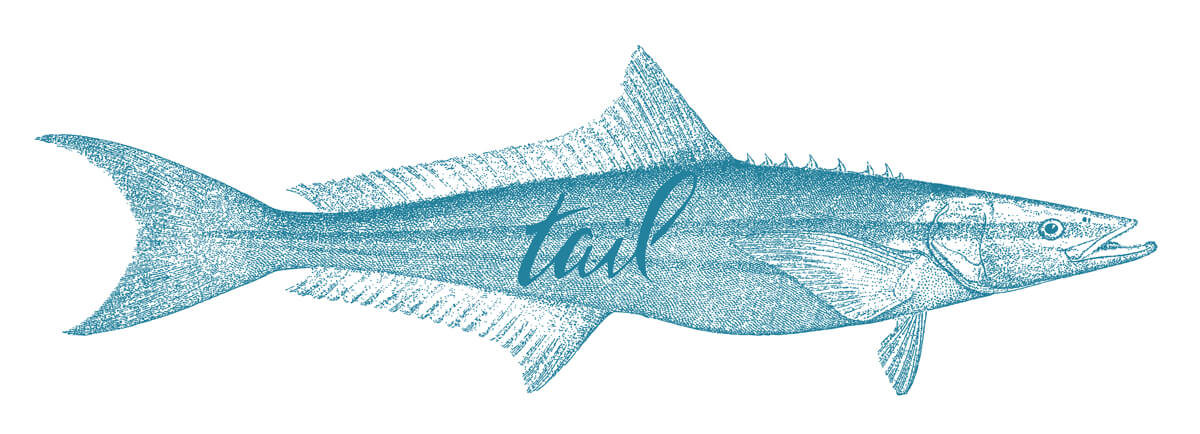 Often while I’m idling down tidelines in search of cobia I run across another favorite, the tripletail. Tripletail look a lot like something you’d catch in Miami while fishing for peacock bass. The dorsal, tail, and anal fin all sweep back to look as if the fish has three tails. Tripletail, or T3s as the guides call them, are not particularly easy to please, like cobia, but they’re very predictable. T3s often seek refuge under anything and everything. One of the best T3s I ever caught was hiding underneath an empty bottle of rubbing alcohol that was floating in a weed line. These targets look like a giant bluegill on their sides, bobbing in the current like a sunken paper bag. You know the fast-swimming, aggressive, apex predator types, right? Well, this isn’t one of them. I like to present a small 1/0 to 3/0 baitfish or shrimp pattern just right to get the bite. Just right, to me, is a fly passing slowly by the fish as if it doesn’t recognize the threat at all. Go to your local bait shop and watch shrimp crawl around in the tank. That’s how I like my fly to float by a tripletail. In the Lowcountry, tripletail can weigh anywhere from a couple of pounds to 30 pounds. So long as you have a 30-pound leader, even an 8-weight rod can get the job done.
Often while I’m idling down tidelines in search of cobia I run across another favorite, the tripletail. Tripletail look a lot like something you’d catch in Miami while fishing for peacock bass. The dorsal, tail, and anal fin all sweep back to look as if the fish has three tails. Tripletail, or T3s as the guides call them, are not particularly easy to please, like cobia, but they’re very predictable. T3s often seek refuge under anything and everything. One of the best T3s I ever caught was hiding underneath an empty bottle of rubbing alcohol that was floating in a weed line. These targets look like a giant bluegill on their sides, bobbing in the current like a sunken paper bag. You know the fast-swimming, aggressive, apex predator types, right? Well, this isn’t one of them. I like to present a small 1/0 to 3/0 baitfish or shrimp pattern just right to get the bite. Just right, to me, is a fly passing slowly by the fish as if it doesn’t recognize the threat at all. Go to your local bait shop and watch shrimp crawl around in the tank. That’s how I like my fly to float by a tripletail. In the Lowcountry, tripletail can weigh anywhere from a couple of pounds to 30 pounds. So long as you have a 30-pound leader, even an 8-weight rod can get the job done.
When I think of migratory species, ones that can make an angler cry uncle, I think of jack crevalle. We’re not talking about the 5- to 10-pound jacks you caught on your last trip to Tampa. We’re talking about the vicious 30-pound ass-whoopers that sound to 50 feet and admire every clamshell on the bottom while your muscles tremble. Early June marks the beginning of giant jack season. Similar to cobia, calm conditions are necessary as we scan the sounds and beachfronts for large wakes or yellow sickle tails cutting the surface. More often than not, we’re fishing to large schools of jacks rather than solitary predators. This can work to our advantage with the element of competition, or it can work against us like a stampede of antelope evading a big cat. As with most close-quarter predators, the first cast is crucial. If the first presentation is botched, odds are our prized “yeller tails” are going to sound and come back up with a completely different attitude–a bad one. The ultimate jack fly is a big popper on a 5/0 or larger hook. Watching big jacks climb over each other to crush a popper never gets old. Considering the length of the fight and how hot it is here June through September, losing a fish after the first blistering run is no big deal. If you’re married to the idea of landing a giant jack on the fly, I’d suggest going with a 6-inch streamer in green and white to match the menhaden that jack crevalle follow into our waters. Deceivers, Whistlers, EP baitfish, and anything in between will get the bite so long as it acts right under the surface. Acting right is open to interpretation, of course, but I like short, fast strips. Long, slow strips do not create a sense of urgency. Urgency creates chaos, and both of these are great for fly fishing. Rods 10- through 12-weight do a great job of pulling on jack crevalle. Weight-forward floating and intermediate lines are great for presenting jack food. Don’t be afraid to throw your tarpon outfit at that giant jack. It may be the difference between catching one that morning or catching three.
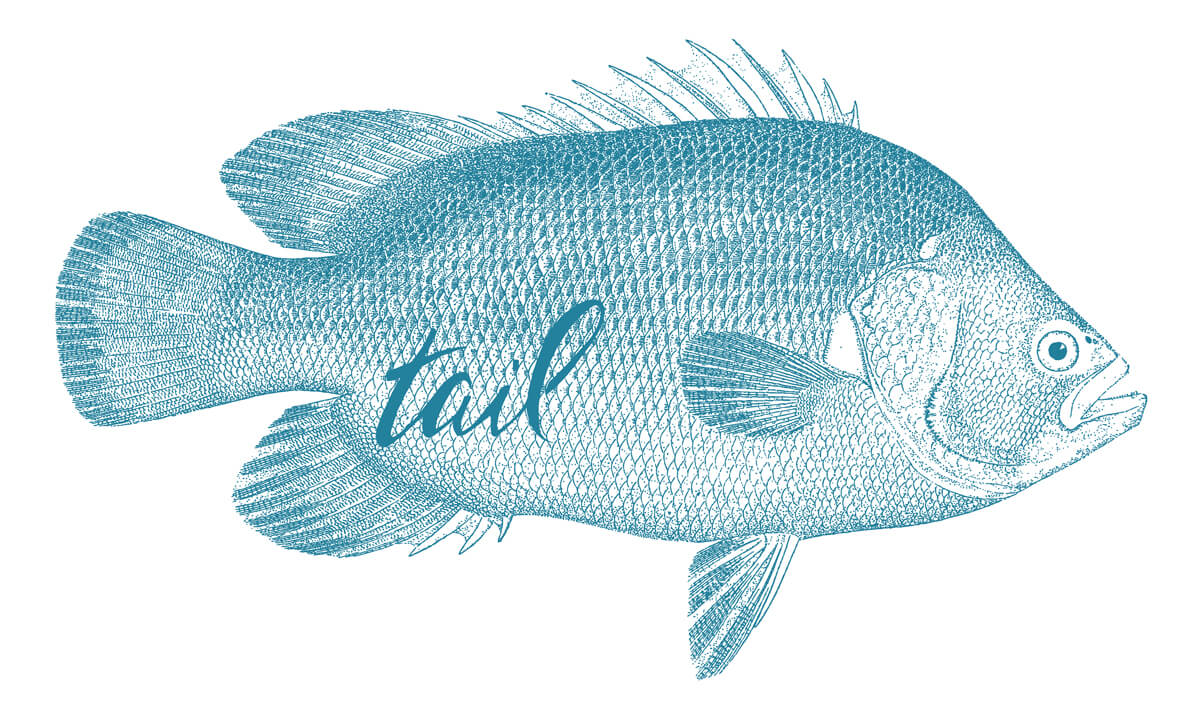
If you’ve ever fished with me you know what I love most: tarpon! Why wouldn’t you love tarpon? They’re huge, shiny fish that eat flies and do flips! I could float around in a school of tarpon for hours without a bite, knowing that at any minute they could turn on. The Lowcountry is an interesting place to fly fish for tarpon. There is just something special about putting a hook in a Lowcountry tarpon, whether it’s a single fish in the salt marsh or a string of 50 in the Atlantic.
Let me state for the record that I am not the authority when it comes to tarpon on the fly, but I sure have put in my time and have some good material for the highlight reel. Tarpon can be found swimming lazily around the marshes, feeding primarily on mullet, or on the beachside blasting through giant schools of menhaden. I prefer the latter because of the visuals. Whether or not I think I can connect with Mr. T, I find it very entertaining to watch these beasts breaching through baitfish pods like Free Willy. I like to throw heavier fly rods for tarpon. A 10-weight is a great choice when the water is 4-feet deep, but around here you can find yourself in 50 feet of water in no time. Not to mention, an average Lowcountry tarpon is 80-plus pounds. I prefer an 11-weight or 12-weight with an intermediate line and 300 yards of backing. If I fish a clear-tip line, I’ll go with a straight 60-pound fluorocarbon leader, about 8 feet or so. Otherwise, I like a 10-foot tapered leader with a 60-pound bite tippet. I don’t waste my time with the 20-pound class leaders because I like either to put the fish in the air or to land them quickly to fight another day. I prefer larger baitfish patters around these parts. I’m a big fan of black/purple and green/white flies on 3/0 or larger hooks. If I’m fishing around baitfish schools, I like my fly to stand out in color or size. A fly as long, or longer, than a beer can should do it. Flies that are shaped like mullet or menhaden should work if the fly is in the right place at the right time.
by Captain Kai Williams
Bio: Captain Kai Williams has lived in Hilton Head for 28 years and has guided anglers for 16 years on kayaks, flats skiffs, and center-console boats. Visit his website at awesomeadventurecharters.com
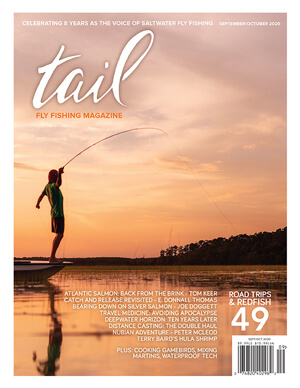 SUBSCRIBE TO TAIL FLY FISHING MAGAZINE TODAY
SUBSCRIBE TO TAIL FLY FISHING MAGAZINE TODAY

